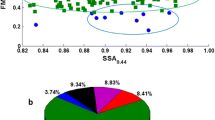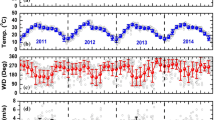Abstract
Columnar and ground-level aerosol optical properties co-located in space and time and retrieved from sun/sky photometer and nephelometer measurements, respectively, have been analyzed to investigate the impact of local and transboundary pollution, to analyze their relationships, and hence to contribute to the aerosol load characterization over the Central Mediterranean. The aerosol optical depth (AOD) at 440 nm, the Ångström exponent (Å) calculated from the AOD at 440 and 675 nm, and the asymmetry parameter (g col ) at 440 nm represent the investigated columnar aerosol parameters. The scattering coefficient (σ p) at 450 nm, the scattering Ångström exponent (å) calculated from σ p at 450 and 635 nm, and the asymmetry parameter (g) at 450 nm are the corresponding ground-level parameters. It is shown that the columnar and ground-level aerosol properties were significantly and similarly affected by the main airflows identified with backtrajectory cluster analysis. The yearly averaged daily evolution of σ p, å, and g was fairly correlated to the one of the AOD, Å, and g col , respectively. These results indicate that the aerosol particles were on average characterized by similar yearly averaged optical properties up to the ground level. In particular, the yearly means of columnar and ground-level Ångström exponents, 1.3 ± 0.4 and 1.1 ± 0.4, respectively, which are close to one, reveal a coarse-mode aerosol contribution in addition to the fine-mode particle contribution up to the ground level. Hourly means, day-by-day, and seasonal daily patterns of ground-level parameters were, however, very weakly correlated with the corresponding columnar parameters. The large impact of the local meteorology on the daily evolution of the ground-level aerosol properties, which makes the impact of long-range transported particles less apparent, was mainly responsible for these last results. It has also been found that columnar Ångström exponents much smaller than one may not be linked to å values smaller than 1. This may occurs when coarse-mode particle plumes, advected at high altitudes, do not penetrate inside the planetary boundary layer. Ångström exponents smaller than 1 are due to a significant contribution of coarse-mode particles as dust particles. Therefore, it is shown that å represents one of the best parameters to infer the contribution of coarse-mode particles at the ground level. The daily evolution of the aerosol properties referring to working days (Monday to Friday) and Sunday and the weekly cycle have suggested that the aerosol source contributions varied during the weekends. In particular, the AOD was characterized by a negative weekly cycle (higher AOD values during the weekend than during the weekdays), the Sunday σ p daily mean was 11 % larger than the Monday value, and å reached the highest value on Sunday. The impact up to the ground level of the weekdays’ transboundary pollution, which reaches the monitoring site during the weekends, has likely contributed to these results.















Similar content being viewed by others
References
Adam M, Putaud JP, Martins dos Santos S, Dell’Acqua A, Gruening C (2012) Aerosol hygroscopicity at a regional background site (Ispra) in Northern Italy. Atmos Chem Phys 12:5703–5717
Amato F, Pandolfi M, Escrig A, Querol X, Alastuey A, Pey J, Perez N, Hopke PK (2009) Quantifying road dust resuspension in urban environment by multilinear engine: a comparison with PMF2. Atmos Environ 43:2770–2780
Andrews E, Sheridan PJ, Fiebig M, McComiskey A, Ogren JA, Arnott P, Covert D, Elleman R, Gasparini R, Collins D, Jonsson H, Schmid B, Wang J (2006) Comparison of methods for deriving aerosol asymmetry parameter. J Geophys Res 111, D05S04. doi:10.1029/2004JD005734
Andrews E, Sheridan PJ, Ogren JA (2011) Seasonal differences in the vertical profiles of aerosol optical properties over rural Oklahoma. Atmos Chem Phys 11:10661–10676. doi:10.5194/acp-11-10661-2011
Barnaba F, Tafuro AM, De Tomasi F, Perrone MR (2007) Observed and simulated vertically resolved optical properties of continental aerosols over southeastern Italy: a closure study. J Geophys Res 112, D10203. doi:10.1029/2006JD007926
Basart S, Perez C, Cuevas E, Baldasano JM, Gobbi GP (2009) Aerosol characterization in Northern Africa, Northeastern Atlantic, Mediterranean Basin and Middle East from direct-sun AERONET observations. Atmos Chem Phys 9:8265–8282
Brankov E, Rao ST, Porter PS (1998) A trajectory-clustering correlation methodology for examining the long-range transport of air pollutants. Atmos Environ 32:1525–1534
Collaud Coen M, Weingartner E, Nyeki S, Cozie J, Henning S, Verheggen B, Gehrig R, Baltensperger U (2007) Long-term trend analysis of aerosol variables at the high-alpine site Jungfraujoch. J Geophys Res 112 doi:10.1029/2006JD007995
D’Almeida GA, Keopke P, Shettle EP (1991) Atmospheric aerosol: global climatology and radiative characteristics. A. Deepak Publishing, Hampton
De Tomasi F, Perrone MR (2003) Lidar measurements of tropospheric water vapor and aerosol profiles over southeastern Italy. J Geophys Res 108:4286–4297
Draxler RR (2003) Evaluation of an ensemble dispersion calculation. J Appl Meteorol 42:308–317
Draxler RR, Hess GD (1998) An overview of the HYSPLIT_4 modeling system of trajectories, dispersion, and deposition. Aust Meteorol Mag 47:295–308
Dubovik O et al (2002) Non-spherical aerosol retrieval method employing light scattering by spheroids. J Geophys Res Lett 29(10):1415. doi:10.1029/2001GL014506
Esteve AR, Estelles V, Utrillas MP, Martınez-Lozano JA (2012) In-situ integrating nephelometer measurements of the scattering properties of atmospheric aerosols at an urban coastal site in western Mediterranean. Atmos Environ 47:43–50. doi:10.1016/j.atmosenv.2011.11.043
Georgoulias AK, Kourtidis KA (2011) On the aerosol weekly cycle spatiotemporal variability over Europe. Atmos Chem Phys 11:4611–4632
Gerasopoulos E, Andreae MO, Zerefos CS, Andreae TW, Balis D, Formenti P, Merlet P, Amiridis V, Papastefanou C (2003) Climatological aspects of aerosol optical properties in Northern Greece. Atmos Chem Phys 3:2025–2041. doi:10.5194/acp-3-2025-2003
Holben BN, Eck TF, Slutsker I, Tanré D, Buis JP, Setzer A, Vermote E, Reagan JA, Kaufman YJ, Nakajima T, Lavenu F, Jankowiak I, Smirnof A (1998) AERONET-A federated instrument network and data archive for aerosol characterization. Remote Sens Environ 66(1):1–16
IPCC, Climate Change (2013) The physical science basis, the Working Group I contribution to the UN IPCC’s Fifth Assessment Report (WG1 AR5). Cambridge University Press, New York, pp 159–254
Korras-Carraca MB, Hatzianastassiou N, Matsoukas C, Gkikas A, Papadimas CD (2014) The regime of aerosol asymmetry parameter over Europe, Mediterranean and Middle East based on MODIS satellite data: evaluation against surface AERONET measurements. Atmos Chem Phys Discuss 14:22677–22713. doi:10.5194/acpd-14-22677-2014
Lelieveld J, Berresheim H, Bormann S, Crutzen PJ, Dentener FJ et al (2002) Global air pollution crossroads over the Mediterranean. Science 298:794–799
Lyamani H, Olmo FJ, Alados-Arboledas L (2008) Light scattering and absorption properties of aerosol particles in the urban environment of Granada, Spain. Atmos Environ 42:2630–2642
Lyamani H, Olmo FJ, Alados-Arboledas L (2010) Physical and optical properties of aerosols over an urban location in Spain: seasonal and diurnal variability. Atmos Chem Phys 10:239–254
Mallet M, Dubovik O, Nabat P, Dulac F, Kahn R, Sciare J, Paronis D, Leon JF (2013) Absorption properties of Mediterranean aerosols obtained from multi-year ground-based remote sensing observations. Atmos Chem Phys 13:9195–9210
Müller T, Henzing JS, de Leeuw G, Wiedensohler A (2011) Design and performance of a three-wavelength LED-based total scatter and backscatter integrating nephelometer. Atmos Meas Tech 4:1291–1303
Pandolfi M, Cusack M, Alastuey A, Querol X (2011) Variability of aerosol optical properties in the Western Mediterranean Basin. Atmos Chem Phys 11:8189–8203
Pavese G, De Tomasi F, Calvello M, Esposito F, Perrone MR (2009) Detection of Sahara dust intrusions during mixed advection patterns over south-east Italy: a case study. Atmos Res 92:489–504
Pereira SN, Wagner F, Silva AM (2011) Seven year of measurements of aerosol scattering properties, near the surface, in the southwestern Iberia Peninsula. Atmos Chem Phys 11:17–29
Perrone MR, Bergamo A (2011) Direct radiative forcing during Sahara dust intrusions at a site in the Central Mediterranean: anthropogenic particle contribution. Atmos Res 101:783–798
Perrone MR, Tafuro AM, Kinne S (2012) Dust layer effects on the atmospheric radiative budget and heating rate profiles. Atmos Environ 59:344–354
Perrone MR, Becagli S, Orza JAG, Vecchi R, Dinoi A, Udisti R, Cabello M (2013) The impact of long-range-transport on PM1 and PM2.5 at a Central Mediterranean site. Atmos Environ 71:176–186
Perrone MR, De Tomasi F, Gobbi GP (2014a) Vertically resolved aerosol properties by multi wavelength lidar measurements. Atmos Chem Phys 14:1185–1204. doi:10.5194/acp-14-1185-2014
Perrone MR, Romano S, Orza JAG (2014b) Particle optical properties at a Central Mediterranean site: Impact of advection routes and local meteorology. Atmos Res 145–146:152–167
Santese M, De Tomasi F, Perrone MR (2008) Advection patterns and aerosol optical and microphysical properties by AERONET over south-east Italy in the central Mediterranean. Atmos Chem Phys 8:1881–1896
Schuster GL, Dubovik O, Holben BN (2006) Ångström exponent and bimodal aerosol size distributions. J Geophys Res 111, D07207. doi:10.1029/2005JD006328
Seinfeld JH, Pandis SN (1998) Atmospheric chemistry and physics: from air pollution to climate change. Wiley, INC
Tafuro AM, Barnaba F, De Tomasi F, Perrone MR, Gobbi GP (2006) Saharan dust particle properties over the central Mediterranean. Atmos Res 81:67–93
Tafuro AM, Kinne S, De Tomasi F, Perrone MR (2007) Annual cycle of aerosol direct radiative effect over southeast Italy and sensitivity studies. J Geophys Res 112, D20202. doi:10.1029/2006JD008265
Wiscombe WJ, Grams GW (1976) The backscattered fraction in two-stream approximations. J Atmos Sci 33:2440–2451
Acknowledgments
This work is supported by the European Community through the ACTRIS Research Infrastructure Action under the 7th Framework Programme under ACTRIS Grant Agreement no. 262254. The authors would like to acknowledge the Barcelona Super-Computing Centre for the provision of the DREAM dust profiles. The authors gratefully acknowledge the NOAA Air Resources Laboratory (ARL) for the provision of the HYSPLIT model used in this publication. Dr. S. Di Sabatino and Mr. G. Rispoli are acknowledged for the provision of the local meteorological data.
Author information
Authors and Affiliations
Corresponding author
Additional information
Responsible editor: Gerhard Lammel
Rights and permissions
About this article
Cite this article
Perrone, M.R., Romano, S. & Orza, J.A.G. Columnar and ground-level aerosol optical properties: sensitivity to the transboundary pollution, daily and weekly patterns, and relationships. Environ Sci Pollut Res 22, 16570–16589 (2015). https://doi.org/10.1007/s11356-015-4850-7
Received:
Accepted:
Published:
Issue Date:
DOI: https://doi.org/10.1007/s11356-015-4850-7




